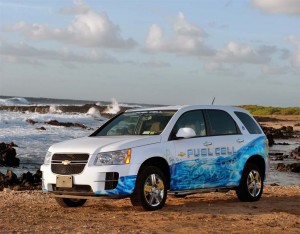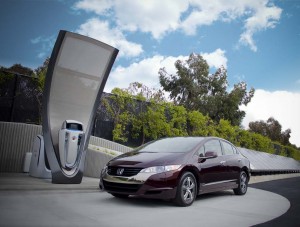
GM and its new partners plan to set up a hydrogen fueling network, in Oahu, for vehicles like this Chevrolet Equinox FCV.
It’s about to get a bit cleaner in paradise. General Motors and 10 of its partners plan to set up a hydrogen fueling network in Hawaii, by 2015, that could make the island state the first truly viable market for zero-emission fuel cell vehicles, or FCVs.
Dubbed the Hawaii Hydrogen Initiative, or H2I, the project has the twin goals of reducing both automotive emissions and the state’s dependence upon foreign oil, sponsors said. Currently, 90% of Hawaii’s energy needs are served by oil, but proponents are looking to harvest renewable power, which is available in abundance – some of which can be used to cleanly produce a steady supply of hydrogen gas.
“In Hawaii, we want to address the proverbial chicken or egg dilemma,” said Charles Freese, executive director of GM Fuel Cell Activities. “There has always been a looming issue over how to ensure that the vehicles and the necessary hydrogen refueling infrastructure are delivered to market at the same time.”
Fuel cell vehicles, such as a version of the Chevrolet Equinox GM has been field testing for several years, are similar to the new battery-electric vehicles now beginning to reach market. Their wheels are turned solely by electric power. But instead of a battery, FCVs rely on a source of energy known as a “stack.”

Honda has set up a solar-powered hydrogen refueling station near Los Angeles for the maker's FCX Clarity.
Hydrogen is piped into one side and the gas then passes through a special membrane to combine with oxygen from the air we breathe. In the process, a current is created that can be used to turn the wheel motors. Meanwhile, the only by-product is water vapor.
The challenge has been to come up with a steady and readily attainable supply of hydrogen. The gas is the most abundant element in the universe but on Earth is not available in a pure form and must be obtained in a variety of ways. But some require the use of “dirty” sources, such as coal or natural gas. The potentially cleanest manner of production is to electrolyze water by applying a high-voltage current. To be truly clean, that energy should come from some form of renewable energy.
The choice of Hawaii is appropriate, as the island state has plenty of access to wind, solar, wave and geothermal energy and is making a push to tap into all of those sources. A 2008 partnership with the Department of Energy (DoE) aims to provide as much as 70% of Hawaii’s energy supply from renewables by 2030.
Last May, GM signed a memorandum of understanding with The Gas Company, one of Hawaii’s biggest utilities, which is already producing enough hydrogen to fuel 10,000 FCVs – and has the capacity to handle significantly more.
Under the H2I plan, a number of other companies, agencies and universities will join in with GM and TGC – 10 partners in all — with a goal of making a hydrogen refueling network a viable reality by 2015. Together they plan to set up between 20 and 25 fueling stations around the state’s most populous island, Oahu.
“Hydrogen, used as a fuel, will reduce our dependence on petroleum starting today,” said Jeff Kissel, TGC president and CEO.
The relatively small size of Oahu will make it easy to handle distribution of the gas – and its use by motorists. Hydrogen has a number of advantages, including not only its cleanliness but, when compared to battery power, the fact that a vehicle can get several miles in range and then refuel in a matter of minutes.
There are downsides, too, though. The gas not only takes a lot of energy to produce cleanly but it is difficult to distribute and store. The good news is that fuel cell stack technology has been improving at a rapid pace. GM’s latest system is barely half the size of the prior generation, produces more power and costs significantly less.
“Once the key hydrogen infrastructure elements are proven in Hawaii, other states can adopt similar approaches,” Freese said. “Germany, Japan and Korea are all building hydrogen infrastructures within this same timeframe. The work in Hawaii can provide a template for other regions.”
Over the last several years, as battery technology has come under the spotlight, the industry – as well as the federal government – has shifted attention away from hydrogen power. The DoE recently reallocated some funds first set aside for fuel cell development to battery programs. But many energy experts believe that, in the long-run, hydrogen is still the power source of choice for transportation.
GM is by no means the only automaker that has continued to work on fuel cell technology. Honda has been marketing a small number of FCX Clarity fuel cell vehicles to consumers in Southern California, where a limited fueling network already exists. Several German makers, including Daimler AG, have meanwhile partnered with the Berlin government to launch a program that could place 1,000 hydrogen fueling and battery recharging stations around that country.
And Iceland, another nation with no local oil sources but plenty of geothermal energy, is also hoping to convert to a hydrogen-powered automobile fleet in the coming decades, though its efforts were set back by the country’s recent financial meltdown.
